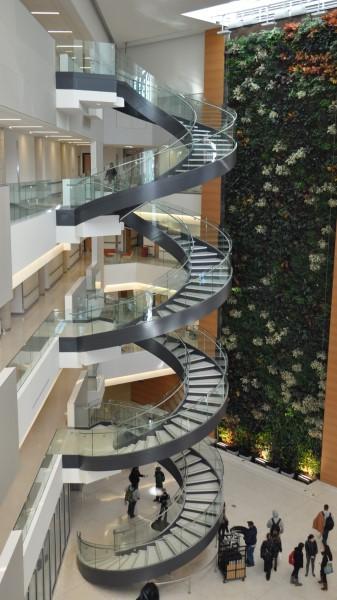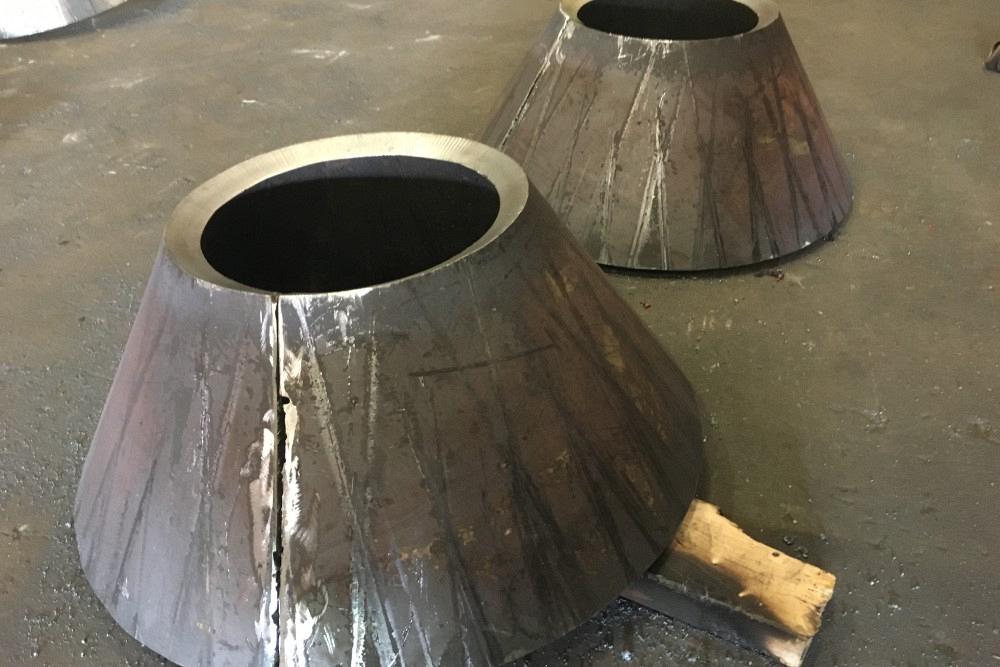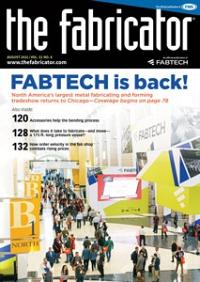Editor-in-Chief
- FMA
- The Fabricator
- FABTECH
- Canadian Metalworking
Categories
- Additive Manufacturing
- Aluminum Welding
- Arc Welding
- Assembly and Joining
- Automation and Robotics
- Bending and Forming
- Consumables
- Cutting and Weld Prep
- Electric Vehicles
- En Español
- Finishing
- Hydroforming
- Laser Cutting
- Laser Welding
- Machining
- Manufacturing Software
- Materials Handling
- Metals/Materials
- Oxyfuel Cutting
- Plasma Cutting
- Power Tools
- Punching and Other Holemaking
- Roll Forming
- Safety
- Sawing
- Shearing
- Shop Management
- Testing and Measuring
- Tube and Pipe Fabrication
- Tube and Pipe Production
- Waterjet Cutting
Industry Directory
Webcasts
Podcasts
FAB 40
Advertise
Subscribe
Account Login
Search
A new definition of precision in plate rolling
Diversification means varied customer expectations for heavy-duty fabricator of rolled, formed parts
- By Dan Davis
- Updated March 6, 2023
- August 16, 2021
- Article
- Bending and Forming

Chicago Metal Rolled Products has 11 plate rolling and sheet rolling machines between its Chicago and Kansas City, Mo., locations. This 2- by 87-in. plate rolled into a 10-ft. ring with bevels on each ends and tack welded is one example of the work it does. Images: Chicago Metal Rolled Products
“I consider myself pretty young,” said Ken Pecho, technical operations engineer for Chicago Metal Rolled Products (CMRP). At 37, he’s not wrong, yet in the eyes of many metal fabricators, he might be considered a grizzled veteran of structural steel fabricating.
He’s been involved with forming plate and structural steel beams, tubes, channels, and angles for about 15 years, which has given him plenty of time to see the changing demands from longtime customers in the building and construction industry and challenging requests from new clients in manufacturing segments. Lead times have shrunk for projects. Customers have bigger and bolder visions for their projects. Materials are evolving and becoming more challenging to work with.
But the CMRP team isn’t intimidated. The company, founded in 1908, has developed its reputation on delivering results when others don’t even want to bother with the difficulty. CMRP has the capability to form round, rectangular, and square tubing from 3/8 to 24 in. OD; bars up to 36 by 12 in.; beams up to 44 in. the hard way (against the strong axis); plate up to 2 in. thick, 12 ft. wide, and 30 ft. long; and other structural forms, such as angles and channels. That type of experience fuels confidence. Taking on extraordinary jobs and pushing the boundaries of competencies now has become a daily habit for the CMRP crew.
The Precision Puzzle
Forming heavy structural members is how CMRP made its name in the structural steel industry, and it’s no stranger to high-profile projects. For example, in 2020 it handled the forming of curved hollow structural steel used in the fabrication of dual 864-ft.-long canopies that were a part of the revitalization of Hartsfield-Jackson Atlanta International Airport and also rolled many of the 1,500 pieces of curved wide-flange steel found in a 166,000-sq.-ft. cruise boat facility near Miami. (The fabrication work for the Atlanta airport won a 2020 International Design Excellence Awards from the Industry Designers Society of America.) Those are just some of the projects that the American Institute of Steel Construction’s Modern Steel Construction regularly features in its pages.
CMRP has a close working relationship with the AISC, the governing body for steel construction standards in the U.S. The company sits on the association’s Bender Roller Committee, which provides advice and insight on the manufacturing tolerances and specifications found in the AISC’s Code of Standard Practice for Steel Buildings and Bridges. (The Bender Roller Committee also includes machine manufacturers like DAVI.)
The funny thing is that many of the architects might have their own ideas of tolerances and specifications. It has become commonplace for CMRP to collaborate on requests where a massive fabrication—say a tube 60 ft. long with 20 in. dia.—is specified with a tolerance of 1/8 in.
“Obviously the larger the structural member is, the larger the tolerance issue is. But it’s still common to see those types of requests like 1/8 in.,” Pecho said.
But the precision challenge doesn’t end there. Like any business, CMRP has diversified its business in recent years as it seeks to avoid being linked too closely with one or two industry segments. That customer diversification effort has led CMRP to win new business in areas such as aerospace, agriculture, and energy development. It’s also led to some new production challenges.
“As we move into these new areas, we see tolerance demands of +/- 1/16 or 1/32. That’s challenged us as we work to achieve these tighter tolerances,” Pecho said.
Consider the work that CMRP has done for a major manufacturer of agricultural equipment. The customer demands that its heavy-duty parts meet tight design and quality specifications because the farmers who are purchasing the equipment expect luxury car looks with farm truck ruggedness and longevity. Big expectations come with the big price tag for these products.

Just how much precision is required when working with plate? CMRP formed 68,000 lbs. of 2-in.-thick, 16-in.-deep plate stringers to create the helical shape of the staircase at the Drexel University Integrated Sciences Building in Philadelphia. The steel flats were rolled to a 4-ft., 4-in. inside radius with a walk-up-turn-left pitch of 33.25 degrees for the inside stair stringers and were rolled to a 9-ft. inside radius with a walk-up-turn-left pitch of 16.92 degrees for the outside stair stringers.
Pecho said this was recently driven home as he walked past tube arms that would be used to support the bucket for a backhoe.
“I was walking past the operator making those parts, and I said, “Wow, I can't even tell where the bend starts. There’s no deformation in this tube. It is absolutely perfect,” he recalled. “It kind of blew my mind, because I’ve been working with Chicago Metal for 15 years and I’ve seen a lot. But that was quality work.”
Getting to that point of being able to deliver precision parts, whether supersized or just plain large, has been a journey for CMRP. Experience plays a huge role, but communication and technology have helped as well.
The Importance of Planning
Not all jobs call for pulling together other aspects of the shop, but when something challenging is about to hit the shop floor, that’s the time CMRP gets the team together, including representatives from purchasing, design, manufacturing, and quality.
If project scope is large enough, such as 300 parts, the purchasing department might be able to go to the mill and flex its buying power, requesting metal from the same heat lot and off the same coil. That helps to control the consistency of the material somewhat, which should eliminate some variability during material processing. Forming large and thick material is challenging enough, but having to cope with material that reacts differently from workpiece to workpiece makes a difficult job even harder.
Team members need to have an honest conversation with engineers and programmers to determine the best way to form the parts, what equipment to use, and perhaps the best operator for the job. (Some machine technicians have an affinity for certain equipment. This can be particularly noticeable with experienced operators who feel more comfortable operating older equipment with joysticks as the control interface instead of newer forming equipment with touchscreen controls.) In some instances, programmers also are able to run simulations to see how the formed part might come to fruition and if there are any concerns to be addressed.
CMRP cited a hypothetical job with 150 to 200 curved beams. That’s a lot of similar forms that can be very time-consuming if done manually, so the planning meeting provides an opportunity to ask the question: Does capacity exist on the shop floor to tackle this, or is some sort of arrangement necessary? Those types of discussions have led to aggressive investment in new technology. For this hypothetical scenario, a small DAVI angle roll machine might make sense. It not only provides the consistency to deliver curved forms that meet specifications, but also the throughput to do the job in a timely manner.
CMRP company officials pointed out that the fabrication work it supplies is marked by thin margins. That means jobs are lost for a matter of $100 or $200. Also, material prices are in constant flux. That’s why the company has been committed to investing in capital equipment that helps it to fabricate parts on time and on budget.
Pecho added that up-front planning provides the chance to talk about how quality expectations are managed. What does the client require, and what steps will CMRP take to meet those expectations? Resulting quality checks might be as simple as measurement checks or actual fabrication of go/no-go fixtures that qualify the form.
This type of early intervention is a hallmark of the CMRP business. The company has been pushing for early involvement in structural steel projects for a very long time.

CMRP also can roll plate into cones. This cone example is 2-in. plate rolled into a cone with a 20-in. minor radius and a 30-in. major radius.
“The earlier we get into these conversations with these guys, the more efficient and the cheaper the bottlenecks are going to be,” Pecho said. “What we don’t want to happen is the building to be about 98% completed on the construction drawings, and all of a sudden we discover something and wonder, ‘How are we going to do this?’ or ‘This is not possible.’”
That latter statement is the real costly one. The entire project can draw to a halt until someone finds an alternative method to deliver on the architect’s vision. For example, it’s common for a customer to request a very large structure member to be bent in a manner that is simply too tight.
When a metal fabricator gets involved early, it can guide a design that is much more feasible—and affordable. Can a very challenging, large formed part be replaced with two more easily formed parts that can be joined together to serve the same support function? Can support beams be designed in a way that opens work up to several metal fabricators instead of just a handful that have specialty equipment and skills? What can be done to avoid a tight bend and resulting distortion in a hollow structural section? When those questions are answered early, surprises and delays can be minimized, which helps to keep a project on time and on budget. Planning pays off.
The Importance of Having the Right Machine Technology
A fabricator like CMRP with deep bending and forming experience has the tools to make complex designs a reality and simple jobs more efficient. To illustrate the point, Pecho described the thought process of taking on a job involving a very challenging material to form—abrasion-resistant (AR) plate.
AR plate has incredible yield strength. (Pecho described one of the first times he witnessed AR plate with 140,000-PSI yield strength being formed as “weird.” As the material was coming out of the roll, it looked light it might start to curve and form a “C,” but it straightened back out. Its inherent springback qualities defied the pressures of that early-generation plate rolling machine.) That leads to questions related to the part’s geometry and radius and just how much press tonnage is going to be needed to accomplish the final roll.
“When we see geometries that are too extreme and radii that are too tight, we suggest that the material be bump-formed on a press brake. That is something that Chicago Metal really excels at,” Pecho said.
For those rolled forms of AR plate or other material that do not have the extreme requirements, a variable-axis plate rolling machine can handle the work. That’s where things get interesting. Even though the press brake and the variable geometry plate roll look very different, they have something in common: Each handles difficult-to-form material in much the same way.
Operators of both devices want to impart the radius as early as possible in the material. In a press brake, the material sits over a V die, and a ram is driven into the material to create the form. In a variable-geometry plate rolling machine, the top roll is driven into the material that sits atop two bottom rolls, which actually can move to the sides, replicating the action of a variable V-opening press brake die. Different equipment is influenced by some of the same forming principles. That’s where an operator’s forming experience helps to turn useful forming technology into effective and productive machine tools.
“That’s what the CNC equipment gets you: quantity and repeatability,” Pecho said. “You keep things consistent in high-volume jobs and the repeatable jobs.”
CMRP continues to look at new technology and new ways of forming structural elements and heavy plate. One of its more interesting recent investments was an induction bender that handles up to 12-in. tube. It seemed an easy way to test the waters before jumping all the way into heat induction type of work. That’s a big deal for a shop that has focused on cold bending for most of its existence.
When your shop is the one that people call after they’ve called everyone else about complex forming work, it makes sense to be familiar with the latest technology tools of the trade.
About the Author

Dan Davis
2135 Point Blvd.
Elgin, IL 60123
815-227-8281
Dan Davis is editor-in-chief of The Fabricator, the industry's most widely circulated metal fabricating magazine, and its sister publications, The Tube & Pipe Journal and The Welder. He has been with the publications since April 2002.
Related Companies
subscribe now

The Fabricator is North America's leading magazine for the metal forming and fabricating industry. The magazine delivers the news, technical articles, and case histories that enable fabricators to do their jobs more efficiently. The Fabricator has served the industry since 1970.
start your free subscription- Stay connected from anywhere

Easily access valuable industry resources now with full access to the digital edition of The Fabricator.

Easily access valuable industry resources now with full access to the digital edition of The Welder.

Easily access valuable industry resources now with full access to the digital edition of The Tube and Pipe Journal.
- Podcasting
- Podcast:
- The Fabricator Podcast
- Published:
- 04/16/2024
- Running Time:
- 63:29
In this episode of The Fabricator Podcast, Caleb Chamberlain, co-founder and CEO of OSH Cut, discusses his company’s...
- Trending Articles
Tips for creating sheet metal tubes with perforations

Supporting the metal fabricating industry through FMA

JM Steel triples capacity for solar energy projects at Pennsylvania facility

Are two heads better than one in fiber laser cutting?

Fabricating favorite childhood memories

- Industry Events
16th Annual Safety Conference
- April 30 - May 1, 2024
- Elgin,
Pipe and Tube Conference
- May 21 - 22, 2024
- Omaha, NE
World-Class Roll Forming Workshop
- June 5 - 6, 2024
- Louisville, KY
Advanced Laser Application Workshop
- June 25 - 27, 2024
- Novi, MI


























